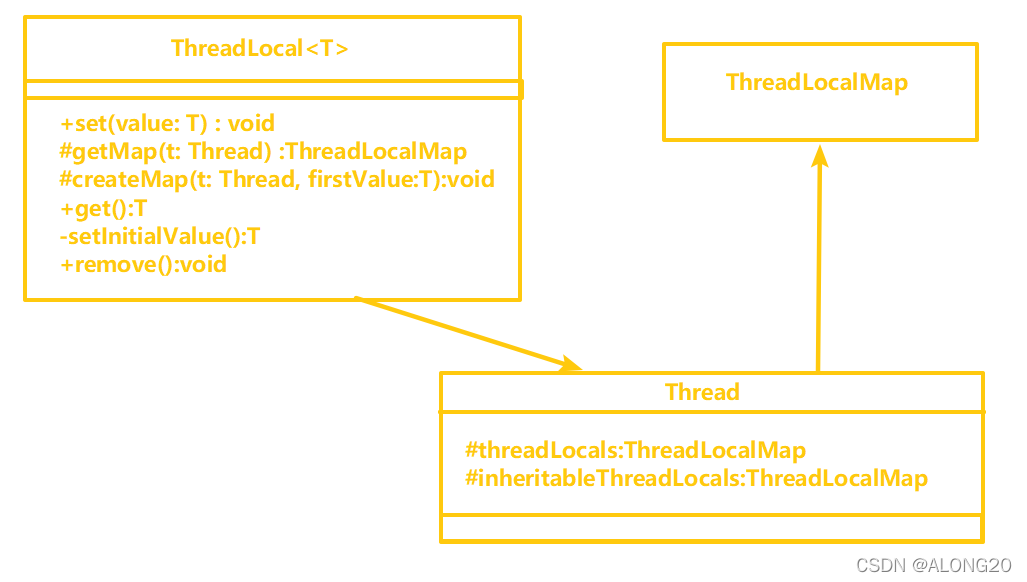概述
多线程访问同一个共享变量的时候容易出现并发问题,特别是多个线程对一个变量进行写入的时候,为了保证线程安全,一般使用者在访问共享变量的时候需要进行额外的同步措施才能保证线程安全性。ThreadLocal是除了加锁这种同步方式之外的一种保证一种规避多线程访问出现线程不安全的方法,当我们在创建一个变量后,如果每个线程对其进行访问的时候访问的都是线程自己的变量这样就不会存在线程不安全问题。
通常情况下,我们创建的变量是可以被任何一个线程访问并修改的。而使用ThreadLocal创建的变量只能被当前线程访问,其他线程则无法访问和修改,这就是ThreadLocal类的作用。
ThreadLocal原理
ThreadLocal的实现原理就是ThreadLocal里面有一个静态的ThreadLocalMap。
TheadLocal
public void set(T value) {
//(1)获取当前线程(调用者线程)
Thread t = Thread.currentThread();
//(2)以当前线程作为key值,去查找对应的线程变量,找到对应的map
ThreadLocalMap map = getMap(t);
//(3)如果map不为null,就直接添加本地变量,key为当前定义的ThreadLocal变量的this引用,值为添加的本地变量值
if (map != null)
map.set(this, value);
//(4)如果map为null,说明首次添加,需要首先创建出对应的map
else
createMap(t, value);
}
/**返回Thread.threadLocals属性*/
ThreadLocalMap getMap(Thread t) {
return t.threadLocals;
}
/**创建ThreadLocalMap实例,并且赋值给Thread.threadLocals属性*/
void createMap(Thread t, T firstValue) {
t.threadLocals = new ThreadLocalMap(this, firstValue);
}
public T get() {
//(1)获取当前线程
Thread t = Thread.currentThread();
//(2)获取当前线程的threadLocals变量
ThreadLocalMap map = getMap(t);
//(3)如果threadLocals变量不为null,就可以在map中查找到本地变量的值
if (map != null) {
ThreadLocalMap.Entry e = map.getEntry(this);
if (e != null) {
@SuppressWarnings("unchecked")
T result = (T)e.value;
return result;
}
}
//(4)执行到此处,threadLocals为null,调用该更改初始化当前线程的threadLocals变量
return setInitialValue();
}
Thread.threadLocals
Thread包含ThreadLocalMap属性,key为ThreadLoad,value为业务具体设置的值。
public class Thread implements Runnable {
/* ThreadLocal values pertaining to this thread. This map is maintained
* by the ThreadLocal class. */
ThreadLocal.ThreadLocalMap threadLocals = null;
/*
* InheritableThreadLocal values pertaining to this thread. This map is
* maintained by the InheritableThreadLocal class.
*/
ThreadLocal.ThreadLocalMap inheritableThreadLocals = null;
}
ThreadLocalMap
ThreadLocalMap内部实际上是一个Entry数组。
static class ThreadLocalMap {
/**
* The entries in this hash map extend WeakReference, using
* its main ref field as the key (which is always a
* ThreadLocal object). Note that null keys (i.e. entry.get()
* == null) mean that the key is no longer referenced, so the
* entry can be expunged from table. Such entries are referred to
* as "stale entries" in the code that follows.
*/
static class Entry extends WeakReference<ThreadLocal<?>> {
/** The value associated with this ThreadLocal. */
Object value;
Entry(ThreadLocal<?> k, Object v) {
super(k);
value = v;
}
}
/**
* The initial capacity -- MUST be a power of two.
*/
private static final int INITIAL_CAPACITY = 16;
/**
* The table, resized as necessary.
* table.length MUST always be a power of two.
*/
private Entry[] table;
/**
* The number of entries in the table.
*/
private int size = 0;
/**
* The next size value at which to resize.
*/
private int threshold; // Default to 0
}
Entry
/**
* 是继承自WeakReference的一个类,该类中实际存放的key是
* 指向ThreadLocal的弱引用和与之对应的value值(该value值
* 就是通过ThreadLocal的set方法传递过来的值)
* 由于是弱引用,当get方法返回null的时候意味着坑能引用
*/
static class Entry extends WeakReference<ThreadLocal<?>> {
/** value就是和ThreadLocal绑定的 */
Object value;
//k:ThreadLocal的引用,被传递给WeakReference的构造方法
Entry(ThreadLocal<?> k, Object v) {
super(k);
value = v;
}
}
//WeakReference构造方法(public class WeakReference<T> extends Reference<T> )
public WeakReference(T referent) {
super(referent); //referent:ThreadLocal的引用
}
//Reference构造方法
Reference(T referent) {
this(referent, null);//referent:ThreadLocal的引用
}
Reference(T referent, ReferenceQueue<? super T> queue) {
this.referent = referent;
this.queue = (queue == null) ? ReferenceQueue.NULL : queue;
}
InheritableThreadLocal类
ThreadLocal类是不能提供子线程访问父线程的本地变量的,而InheritableThreadLocal类则可以做到这个功能。
public class InheritableThreadLocal<T> extends ThreadLocal<T> {
protected T childValue(T parentValue) {
return parentValue;
}
ThreadLocalMap getMap(Thread t) {
return t.inheritableThreadLocals;
}
void createMap(Thread t, T firstValue) {
t.inheritableThreadLocals = new ThreadLocalMap(this, firstValue);
}
}
InheritableThreadLocal类继承了ThreadLocal类,并重写了childValue、getMap、createMap三个方法。其中createMap方法在被调用(当前线程调用set方法时得到的map为null的时候需要调用该方法)的时候,创建的是inheritableThreadLocal而不是threadLocals。同理,getMap方法在当前调用者线程调用get方法的时候返回的也不是threadLocals而是inheritableThreadLocal。
重写的childValue方法在什么时候执行,怎样让子线程访问父线程的本地变量值。我们首先从Thread类开始说起。
private void init(ThreadGroup g, Runnable target, String name,
long stackSize) {
init(g, target, name, stackSize, null, true);
}
private void init(ThreadGroup g, Runnable target, String name,
long stackSize, AccessControlContext acc,
boolean inheritThreadLocals) {
//判断名字的合法性
if (name == null) {
throw new NullPointerException("name cannot be null");
}
this.name = name;
//(1)获取当前线程(父线程)
Thread parent = currentThread();
//安全校验
SecurityManager security = System.getSecurityManager();
if (g == null) { //g:当前线程组
if (security != null) {
g = security.getThreadGroup();
}
if (g == null) {
g = parent.getThreadGroup();
}
}
g.checkAccess();
if (security != null) {
if (isCCLOverridden(getClass())) {
security.checkPermission(SUBCLASS_IMPLEMENTATION_PERMISSION);
}
}
g.addUnstarted();
this.group = g; //设置为当前线程组
this.daemon = parent.isDaemon();//守护线程与否(同父线程)
this.priority = parent.getPriority();//优先级同父线程
if (security == null || isCCLOverridden(parent.getClass()))
this.contextClassLoader = parent.getContextClassLoader();
else
this.contextClassLoader = parent.contextClassLoader;
this.inheritedAccessControlContext =
acc != null ? acc : AccessController.getContext();
this.target = target;
setPriority(priority);
//(2)如果父线程的inheritableThreadLocal不为null
if (inheritThreadLocals && parent.inheritableThreadLocals != null)
//(3)设置子线程中的inheritableThreadLocals为父线程的inheritableThreadLocals
this.inheritableThreadLocals =
ThreadLocal.createInheritedMap(parent.inheritableThreadLocals);
this.stackSize = stackSize;
tid = nextThreadID();
}
在init方法中,首先(1)处获取了当前线程(父线程),然后(2)处判断当前父线程的inheritableThreadLocals是否为null,然后调用createInheritedMap将父线程的inheritableThreadLocals作为构造函数参数创建了一个新的ThreadLocalMap变量,然后赋值给子线程。下面是createInheritedMap方法和ThreadLocalMap的构造方法。
static ThreadLocalMap createInheritedMap(ThreadLocalMap parentMap) {
return new ThreadLocalMap(parentMap);
}
private ThreadLocalMap(ThreadLocalMap parentMap) {
Entry[] parentTable = parentMap.table;
int len = parentTable.length;
setThreshold(len);
table = new Entry[len];
for (int j = 0; j < len; j++) {
Entry e = parentTable[j];
if (e != null) {
@SuppressWarnings("unchecked")
ThreadLocal<Object> key = (ThreadLocal<Object>) e.get();
if (key != null) {
//调用重写的方法
Object value = key.childValue(e.value);
Entry c = new Entry(key, value);
int h = key.threadLocalHashCode & (len - 1);
while (table[h] != null)
h = nextIndex(h, len);
table[h] = c;
size++;
}
}
}
}
在构造函数中将父线程的inheritableThreadLocals成员变量的值赋值到新的ThreadLocalMap对象中。返回之后赋值给子线程的inheritableThreadLocals。总之,InheritableThreadLocals类通过重写getMap和createMap两个方法将本地变量保存到了具体线程的inheritableThreadLocals变量中,当线程通过InheritableThreadLocals实例的set或者get方法设置变量的时候,就会创建当前线程的inheritableThreadLocals变量。而父线程创建子线程的时候,ThreadLocalMap中的构造函数会将父线程的inheritableThreadLocals中的变量复制一份到子线程的inheritableThreadLocals变量中。
ThreadLocal 最佳实践
每次使用完ThreadLocal,都调用它的remove()方法,清除数据。
ThreadLocal问题
ThreadLocal中的弱引用
1.为什么ThreadLocalMap使用弱引用存储ThreadLocal?
假如使用强引用,当ThreadLocal不再使用需要回收时,发现某个线程中ThreadLocalMap存在该ThreadLocal的强引用,无法回收,造成内存泄漏。
因此,使用弱引用可以防止长期存在的线程(通常使用了线程池)导致ThreadLocal无法回收造成内存泄漏。
2.那通常说的ThreadLocal内存泄漏是如何引起的呢?
我们注意到Entry对象中,虽然Key(ThreadLocal)是通过弱引用引入的,但是value即变量值本身是通过强引用引入。
这就导致,假如不作任何处理,由于ThreadLocalMap和线程的生命周期是一致的,当线程资源长期不释放,即使ThreadLocal本身由于弱引用机制已经回收掉了,但value还是驻留在线程的ThreadLocalMap的Entry中。即存在key为null,但value却有值的无效Entry。导致内存泄漏。
但实际上,ThreadLocal内部已经为我们做了一定的防止内存泄漏的工作。
private Entry getEntryAfterMiss(ThreadLocal<?> key, int i, Entry e) {
Entry[] tab = table;
int len = tab.length;
while (e != null) {
ThreadLocal<?> k = e.get();
if (k == key)
return e;
//如果key为空,清理entry
if (k == null)
expungeStaleEntry(i);
else
i = nextIndex(i, len);
e = tab[i];
}
return null;
}
private int expungeStaleEntry(int staleSlot) {
Entry[] tab = table;
int len = tab.length;
// expunge entry at staleSlot
tab[staleSlot].value = null;
tab[staleSlot] = null;
size--;
// Rehash until we encounter null
Entry e;
int i;
for (i = nextIndex(staleSlot, len);
(e = tab[i]) != null;
i = nextIndex(i, len)) {
ThreadLocal<?> k = e.get();
if (k == null) {
e.value = null;
tab[i] = null;
size--;
} else {
int h = k.threadLocalHashCode & (len - 1);
if (h != i) {
tab[i] = null;
// Unlike Knuth 6.4 Algorithm R, we must scan until
// null because multiple entries could have been stale.
while (tab[h] != null)
h = nextIndex(h, len);
tab[h] = e;
}
}
}
return i;
}
上述方法的作用是擦除某个下标的Entry(置为null,可以回收),同时检测整个Entry[]表中对key为null的Entry一并擦除,重新调整索引。
该方法,在每次调用ThreadLocal的get、set、remove方法时都会执行,即ThreadLocal内部已经帮我们做了对key为null的Entry的清理工作。
但是该工作是有触发条件的,需要调用相应方法,假如我们使用完之后不做任何处理是不会触发的。
①强引用:Java中默认的引用类型,一个对象如果具有强引用那么只要这种引用还存在就不会被GC。
②软引用:简言之,如果一个对象具有弱引用,在JVM发生OOM之前(即内存充足够使用),是不会GC这个对象的;只有到JVM内存不足的时候才会GC掉这个对象。软引用和一个引用队列联合使用,如果软引用所引用的对象被回收之后,该引用就会加入到与之关联的引用队列中
③弱引用(这里讨论ThreadLocalMap中的Entry类的重点):如果一个对象只具有弱引用,那么这个对象就会被垃圾回收器GC掉(被弱引用所引用的对象只能生存到下一次GC之前,当发生GC时候,无论当前内存是否足够,弱引用所引用的对象都会被回收掉)。弱引用也是和一个引用队列联合使用,如果弱引用的对象被垃圾回收期回收掉,JVM会将这个引用加入到与之关联的引用队列中。若引用的对象可以通过弱引用的get方法得到,当引用的对象呗回收掉之后,再调用get方法就会返回null
④虚引用:虚引用是所有引用中最弱的一种引用,其存在就是为了将关联虚引用的对象在被GC掉之后收到一个通知。(不能通过get方法获得其指向的对象)






















 4844
4844











 被折叠的 条评论
为什么被折叠?
被折叠的 条评论
为什么被折叠?










